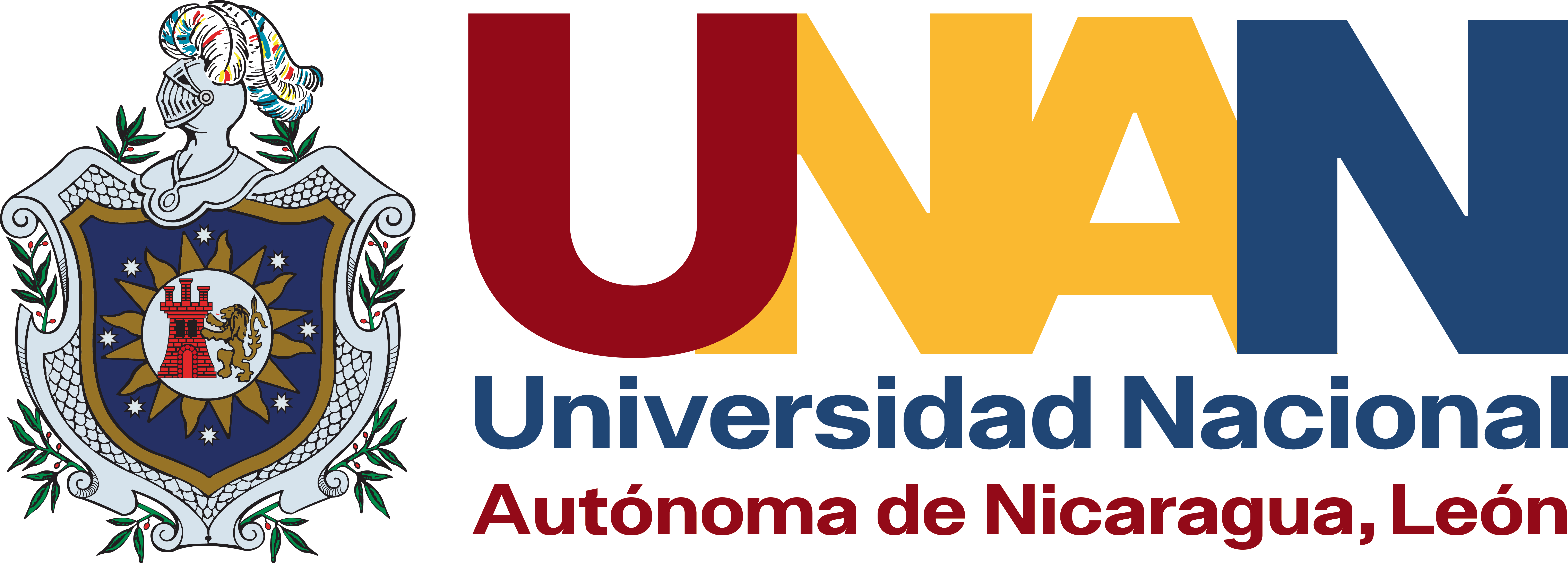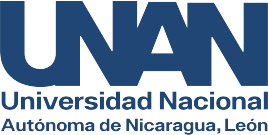Use of endophytic isolates of Trichoderma spp., for the biocontrol of Fusarium oxysporum f. sp. cubense (Panama disease) race 1 in vitro banana plants of the cultivar Gros Michel (AAA) under greenhouse conditions
DOI:
https://doi.org/10.5377/universitas.v4i1.1676Keywords:
Usarium oxysporum f. sp. cubense, Panama disease, GrosMichel (AAA), Endophytic fungi, Biologic control, Trichoderma spp.Abstract
The objective of the present investigation was to select endophytic isolates of Trichoderma spp., for the biocontrol of Fusarium oxysporum f. sp. cubense race 1. The three most pathogenic isolates FOC2, FOC4, FOC8 obtained from the cryobank of the CATIE Phytopathology Laboratory were evaluated in an antibiosis test and subsequently the biocontrol test was carried out with twenty endophytic isolates of Trichoderma spp. And two isolates FOC2 and FOC4 in vitroplants of Gros Michel (AAA) under greenhouse conditions. Using the co-culture technique, twenty Trichoderma spp. isolates inhibited the radial growth of FOC by up to 53.46%. In the biocontrol bioassay, the endophytic isolates of Trichoderma spp., presented a minimum percentage of incidence with 37.5% of the TJ5 treatment, compared to the absolute control that did not present incidence. Likewise, the TC9, TP3 and TCL1 treatments reduced external symptoms from 92% to 90% compared to the reference controls. Internal corm symptoms were reduced up to 74% by the TC9 treatment. Additionally, it was detected that plants protected with endophytic isolates of Trichoderma spp., promoted the vegetative growth of the plant in root and foliage weight.
Downloads
References
Aurore, G; Parfait, B; Fahrasmane, L. (2009), Bananas, raw material for making processed food product. Trend in Food Science & Technology 20:78-91. https://doi.org/10.1016/j.tifs.2008.10.003
Cañizares, C. (2003), Estudio sobre poblaciones de hongos endofíticos provenientes de suelos supresivos al nematodo barrenador Radopholus similis (Cobb) Thorne en plantaciones comerciales de plátano en la zona de Talamanca, Tesis Mag. Sc., Centro Agronómico de Investigación y Enseñanza (CATIE), Turrialba, Costa Rica, 2003, 75 p.
Di Rienzo, A.J., Macchiavelli, R., Casanoves, F. (2009), Modelos Mixtos en InfoStat. Tutorial, Grupo InFoStat, FCA, Universidad Nacional de Córdoba, Argentina. 193 p.
Harman, G.E., Howell, C.R., Viterbo, A., Chet, I., Lorito, M. (2004), Trichoderma species- opportunistic, avirulent plant symbionts. Nature Review Microbiology 2,43-56. https://doi.org/10.1038/nrmicro797
Howell, CR. (2003). Mechanisms employed by Trichoderma species in the biological control of plant diseases: The history and evolution of current concepts. Plant Disease 87(1),4-10. https://doi.org/10.1094/PDIS.2003.87.1.4
Lara, D. (2009), Uso de bacterias endofíticas para el control biológico del Mal de Panamá (Fusarium oxysporum f. sp. cubense) en el cultivar Gros Michel (AAA). Tesis Mag. Sc. Centro Agronómico de Investigación y Enseñanza (CATIE), Turrialba, Costa Rica, 85 p.
Menjivar, RD. (2005), Estudio del potencial antagonista de hongos endofíticos para el biocontrol del nematodo barrenador Radopholus similis en plantaciones de banano en Costa Rica. Tesis Mag. Sc., Centro Agronómico de Investigación y Enseñanza (CATIE), Turrialba, Costa Rica, 69 p.
Mitov, N., Oliva, P. (1975), Estudio sobre el Mal de Panamá del Plátano en Cuba. Revista de Agricultura 8(2),12-29.
Moore, N.Y., Bentley, S., Pegg, K.G., Jones, D.R. (1995), Fusarium wilt of banana. INIBAP. Musa Disease no.5:1-4.
Orjeda, G. (1998), Evaluation of Musa germplasm for resistance to Sigatoka diseases and Fusarium wilt. INIBAP (International Network for improvement of banana and Plantain). Montepellier, Francia 19-29 p.
Pérez, L., Batlle, A., Chacón, J., Montenegro, V. (2009), Eficacia de Trichoderma harzianum A34 en el biocontrol de Fusarium oxysporum f. sp. cubense, agente causal de la marchitez por Fusarium o Mal de Panamá de los bananos en Cuba. Fitosanidad 13(4),259-263.
Pocasangre, L.E. (2008), Estado actual y manejo del Mal de Panamá en América Latina y el Caribe. In XVIII Reunión internacional de la Asociación para la cooperación en investigaciones de bananos en el Caribe y la América Tropical. Acorbat 10 al 14 de nov. Guayaquil, Ecuador. Resúmenes. p. 31.
Pocasangre, L.E. (2009). Estado actual y manejo del manejo de Panamá en América Latina y el Caribe. In Reunión de grupo de interés sobre los riesgos de la raza tropical 4 de Fusarium, bbtv y otras plagas de Musáceas para la región del OIRSA, América Latina y el Caribe (Documentos de Programa y Resúmenes de la Reunión). 29 al 31 de julio. OIRSA, San Salvador, El Salvador. 18 p.
Pocasangre, L; Perez-Vicente, L. 2010. Impacto potencial de la entrada de la raza tropical 4 del Mal de Panamá (Fusarium oxysporum f. sp. cubense) en la industria bananera y platanera de América Latina y el Caribe. In Pocasangre, LE; Perez, L; Martínez, E; Tapia, A; Guzmán, M; Brown, D. eds. Taller de entrenamiento sobre el diagnóstico y caracterización de la marchitez por Fusarium o Mal de Panamá. 22 al 26 de febrero, Turrialba, CR. 3 p.
Ploetz, R.C. (1994), Panama disease: return of the first banana menace. International journal of pest management 40(4),326-336.https://doi.org/10.1080/09670879409371908
Ploetz, R.C. (2006), Fusarium wilt of bananas is caused by several pathogens referred to as Fusarium oxysporum f. sp. cubense. Phytopathology 96(6),653-656. https://doi.org/10.1094/PHYTO-96-0653
Thangavelu, R., Velazhahan, R., Santhiamoorthy, S. (2003), Biocontrol of fusarium wilt disease. In 2nd International symposium on fusarium wilt on banana. Programme and abstracts. 22-26 sept. Salvador de Bahia, BR. 34 p.
Vinale, F., Sivasithamparam, K., Ghisalberti, E.L., Marra, R., Woo, S.L., Lorito, M. (2008), Trichoderma-plant-pathogen interactions. Soil Bioloy & Biochemistry 40,1-10. https://doi.org/10.1016/j.soilbio.2007.07.002
Woo, S.L., Scala, F., Ruooco, M., Lorito, M. (2006), The molecular biology of the interactions between Trichoderma spp., Phytopathogenic Fungi, and plants. Phytopathology 96,181-185. https://doi.org/10.1094/PHYTO-96-0181
Downloads
Published
How to Cite
Issue
Section
License
Copyright (c) 2013 National Autonomous University of Nicaragua, Leòn

This work is licensed under a Creative Commons Attribution-NonCommercial-ShareAlike 4.0 International License.
Copyright © 2025 Universitas (León), Revista Cientifíca de la UNAN-León. Academic Direction. Research Department. Publication and Scientific Event Unit.










